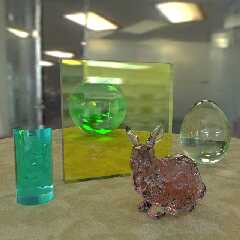 |
 |
|
 |
|
 |
|  |
|  |
|
 |
|
 |
|  |
|  |
|
 |
Op 9-8-2022 om 17:18 schreef Chris R:
> This is why I love working with POV and this community. There's always someone
> who has thought about the same problems and is willing to share their experience
> (and code!)
>
I uploaded my scene file in p.b.scene-files (same subject line).
Enjoy!
--
Thomas
Post a reply to this message
|
 |
|  |
|  |
|
 |
|
 |
|  |
|  |
|
 |
Le 2022-08-09 à 10:50, Thomas de Groot a écrit :
> Op 9-8-2022 om 14:53 schreef Thomas de Groot:
>> initially, I wanted to concentrate on the hdr light sources though...
>>
> ...and when I do, no photons are generated!
>
> I use
> photons {
> refraction on
> reflection on
> }
>
> for the sphere with the hdr map, identical to the code for the light
> source. Decreasing spacing down to a ridiculously small value doesn't
> change anything. I must be missing something here...
>
The HDR map never emit photons.
What you can do to get caustics from an HDR map is to use radiosity. As
the surface receiving the caustics is close to the objects causing it,
your radiosity settings can still be lenient. You only a small
error_bound value.
Try this as a starter :
global_settings{ assumed_gamma 1
radiosity{
error_bound 0.1 // may try smaller
count 150 1111
low_error_factor 0.2
pretrace_end 0.005
}
}
Post a reply to this message
|
 |
|  |
|  |
|
 |
|
 |
|  |
|  |
|
 |
Le 2022-08-09 à 08:43, Thomas de Groot a écrit :
> Op 9-8-2022 om 11:40 schreef Mr:
>> Was it slow to render ? There seems to be no anti aliasing.
>>
> I used +a0.3 +am2 +bm2 +bs8 maybe not the best aa setting but I was
> playing ;-)
>
> I think total render time was about 2 hours or a bit more.
>
Just using +a0.1 instead of +0.3 should improve the result and should
not increase the rendering time to much.
Post a reply to this message
|
 |
|  |
|  |
|
 |
|
 |
|  |
|  |
|
 |
Op 10-8-2022 om 17:42 schreef Alain Martel:
> The HDR map never emit photons.
> What you can do to get caustics from an HDR map is to use radiosity. As
> the surface receiving the caustics is close to the objects causing it,
> your radiosity settings can still be lenient. You only a small
> error_bound value.
>
> Try this as a starter :
>
> global_settings{ assumed_gamma 1
> radiosity{
> error_bound 0.1 // may try smaller
> count 150 1111
> low_error_factor 0.2
> pretrace_end 0.005
> }
> }
Excellent suggestion, concentrating on the caustics! Thanks Alain. This
is the result with:
error_bound 0.01
low_error_factor 0.1
pretrace_start 8/max(image_width,image_height)
pretrace_end 1/max(image_width,image_height)
and stochastic render:
+am3 +a0.01 +ac0.90 +r3
render time was only about 10 minutes.
--
Thomas
Post a reply to this message
Attachments:
Download 'glass_test_04.png' (554 KB)
Preview of image 'glass_test_04.png'

|
 |
|  |
|  |
|
 |
|
 |
|  |




![]()